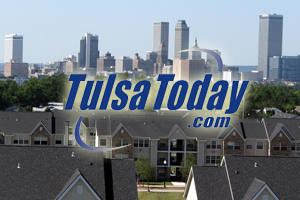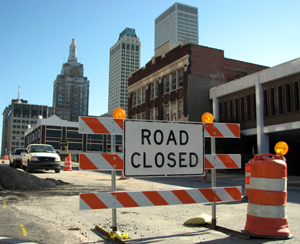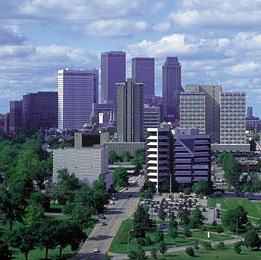 It was 1985 when I first covered Tulsa City government and while the form of that government has changed, the circus is much the same. There is humor, drama, competing agendas, pontificating politicians, disingenuous staff, gossip everywhere and I didn’t even make ALL the meetings Thursday December 13.
It was 1985 when I first covered Tulsa City government and while the form of that government has changed, the circus is much the same. There is humor, drama, competing agendas, pontificating politicians, disingenuous staff, gossip everywhere and I didn’t even make ALL the meetings Thursday December 13.
To attend all, a person must dedicate the day and, I have joked, ease the pain with a bottle in front me or a frontal lobotomy. Ok, it’s not that bad – all the time.
Most of what the City Council does is listening to reports from various departments. At the 10:00 am meeting of the Council’s Capital Improvement Program Task Force, Paul Zachary, Director of Engineering Services, Public Works Department, presented details on the Pavement Management System. In short, the City has spent more in the last 5 years to improve the condition of the streets than they did in the previous 20 years as a result of voter approved bond packages to do just that. You can see street improvements and follow projects online at www.FixOurStreetsLive.com.
 From his detailed presentation, the daily newspaper only covered the need to widen some streets in South Tulsa. Funny, but that area is heavy with “Mac Mansions” and many owners resistant to any widening that might enable more traffic by the “unwashed masses” in their little hills. More on that subject soon. To read the daily’s report, click here.
From his detailed presentation, the daily newspaper only covered the need to widen some streets in South Tulsa. Funny, but that area is heavy with “Mac Mansions” and many owners resistant to any widening that might enable more traffic by the “unwashed masses” in their little hills. More on that subject soon. To read the daily’s report, click here.
Zachary spent the most time explaining the department’s evolving approach to repair. With public money at a higher level, they have been able to solve issues rather than just patch problems. This process involves more planning and coordination with utility providers and various departments like Sewer and Stormwater Management, but it saves tax money over the long and sometimes even short term.
In the afternoon, I attended the Public Works Committee Meeting which was more a regular business function of the Council. Several people were appointed or reappointed to various boards and commissions. Some property was condemned as owners resist selling to gain the highest return possible from the city. Some deeds were dedicated (property given to the city) and thus public business continues.
The City of Tulsa is much like your heart. Few consider the regular operation until a crisis.
 The River Parks Executive Director, Matt Meyers, gave his organization’s quarterly report with some detail, but no written handouts I could see, but he was entertaining and positive on the future of the City and County funded organization. River Parks is the largest linear (longest) park in America. That is cool even if one could wonder why Tulsa needs three park departments, but that is another story. Meyers got the most chuckles from the Council when talking about the recent rash of apparently drunk drivers taking out trees while going cross county headed to the water.
The River Parks Executive Director, Matt Meyers, gave his organization’s quarterly report with some detail, but no written handouts I could see, but he was entertaining and positive on the future of the City and County funded organization. River Parks is the largest linear (longest) park in America. That is cool even if one could wonder why Tulsa needs three park departments, but that is another story. Meyers got the most chuckles from the Council when talking about the recent rash of apparently drunk drivers taking out trees while going cross county headed to the water.
The Transportation Advisory Board Chairman Robin (Jamie) Jamieson next presented the group’s Annual Recommendations. Established in 2009, the Board has been commissioned to advise the Mayor and City Council on all matters affecting land transportation in Tulsa including, but not limited to, streets and rights-of-way maintenance and construction, traffic engineering, mass transit, rail and trail systems.
No surprise here, they demand public investment in mass transit specifically “high-frequency traditional bus service, Bus Rapid Transit, streetcars, light rail and commuter rail.” None of those options are justified by any measure of current or anticipated usage, but, regardless, they demand.
Further, Recommendation #4 states, “Organize, assemble, and define roles and responsibilities of a Task Force, led by the City’s Planning and Economic Development Department or Finance Department or by INCOG, whose mission shall be to determine the most appropriate system of governance for overseeing and developing an expanded transit system serving the City of Tulsa and potentially the metro region. Oversight could be through an expansion of MTTA, or through a newly created city and/or regional transit authority.”
 Tulsa needs another Task Force and increased “governance” like it needs more squirrels, but the apparent objective is to force public transit regardless of a lack of demonstrated need or available budget. To read more on this volunteer Board, click here.
Tulsa needs another Task Force and increased “governance” like it needs more squirrels, but the apparent objective is to force public transit regardless of a lack of demonstrated need or available budget. To read more on this volunteer Board, click here.
Jamieson said, “An effective mass transit system is not an end in itself, but having busy streets of enthusiastic people (young and old, people in wheelchairs, children, everybody) able to just enjoy living in a complex, stimulating, competitive city. That is the desired outcome of this.”
From this and other public statements, Jamieson believes Tulsa must become denser. He doesn’t like our neighborhoods with large yards and gardens, but insists we become more urban and compressed into smaller spaces. All hail the planners who, from the top down, know so much more than the market or the private property owners in Tulsa.
Yes, just another day at City Hall.
